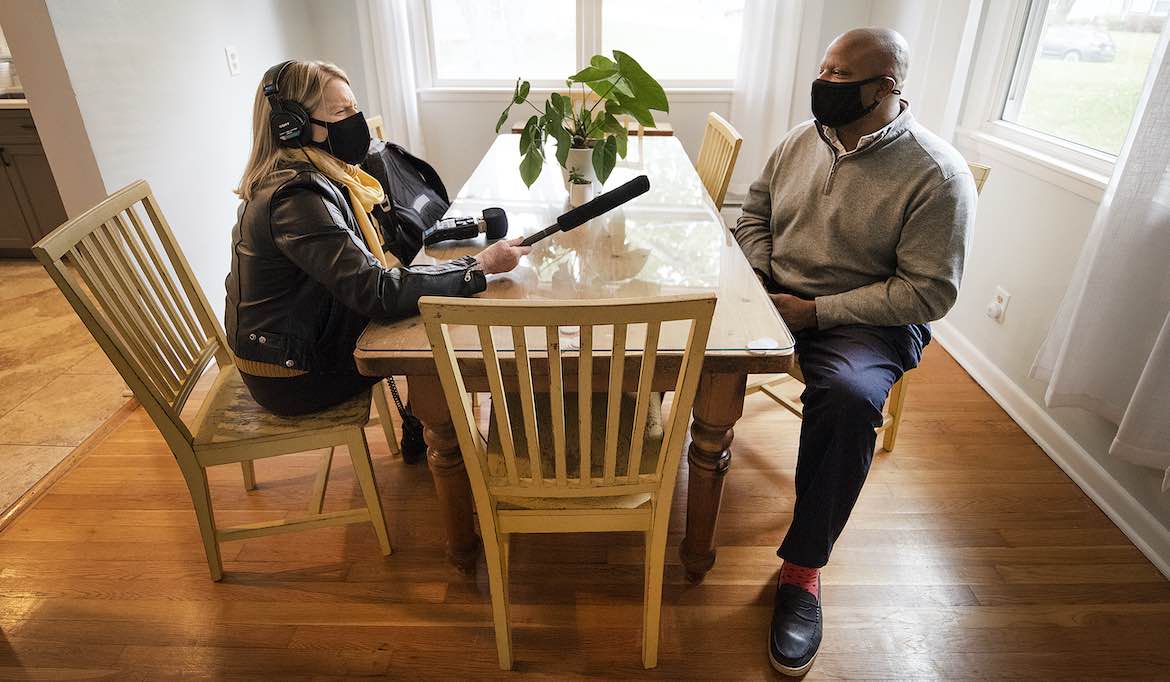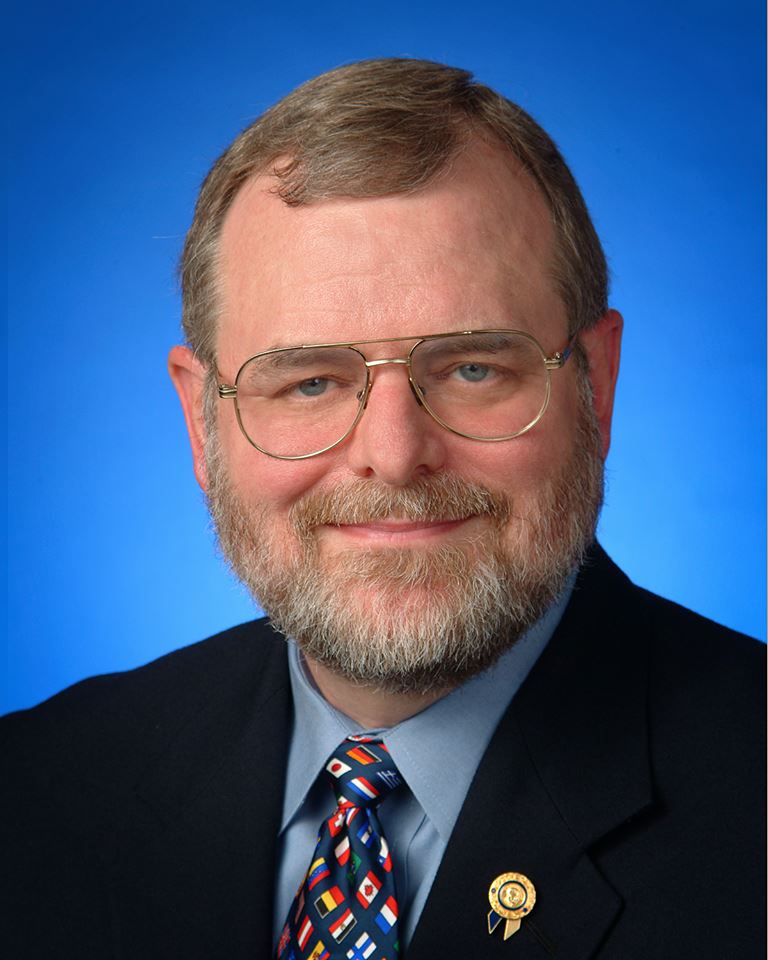How Wisconsin Public Radio is using surveys to track diversity of its sources

Angela Major / WPR
Wisconsin Public Radio reporter Shamane Mills interviews Lane Manning, a Dane County realtor who had recovered from COVID-19.
Many of us at Wisconsin Public Radio have long recognized that the vast majority of sources heard in our news coverage and talk shows are white. The lack of diversity in the voices heard on-air is a problem that many newsrooms have struggled with and are trying with urgency to address.
WPR began working towards a solution two years ago, and this summer we completed our first comprehensive analysis of sources appearing in newscasts, feature reporting and talk shows.
The results confirmed what staff in the newsroom and on the Ideas Network expected, but the methodology we put into place gives us a way to improve and measure our progress. Our goal is to collect and share our source-tracking data publicly and to hold ourselves accountable for reflecting the diversity of our communities in WPR’s programming.
This initiative started in 2018, when I pitched an idea to my boss, WPR News Director Noah Ovshinksy: Let’s track the demographics of every source we have on air by asking them to tell us their demographics, rather than make educated guesses. If we could start by collecting this information from our sources themselves, we would be able to define the extent of the problem and make plans to better meet WPR’s stated goal of serving all the people of Wisconsin.
At that time, staff on WPR’s talk show-focused Ideas Network were tracking race and gender demographics of their guests by drawing information from pre-interviews, online biographies or photographs. If they couldn’t determine the demographics, they had the option to choose “unknown” in our data-gathering system.
On the newsroom side, volunteers in one of WPR’s bureaus did similar research over several months. Their work was compiled into reports that were shared with staff. But relying on guesswork to document source diversity was problematic and the research didn’t translate into actionable data that we were confident sharing with our audience.
I teamed up with Jennifer Dargan, assistant director of The Ideas Network, to create a source-tracking process that worked for both the newsroom and talk shows. Over the course of nine months, Dargan and I developed the source survey, worked with web developers to create the data-gathering system and created a workflow for producing regular analysis.
We met with staff at the University of Wisconsin Survey Center to discuss the best approach for our survey. They advised us to keep it short and send email reminders to sources to achieve a significant response rate. We also met with reporters and producers to hear their feedback on what demographic information would be most useful to them and how to create a workflow that wouldn’t be burdensome.
In August of this year, WPR published its first analysis from this new methodology. The Source Demographic Report shared findings from a yearlong survey research project in which sources who were interviewed and heard on air answered basic demographic questions.
Starting from scratch
There were three main goals for the project: survey sources themselves to gather the most accurate data about their demographic characteristics; create a system that requires the least amount of additional work for reporters and producers; and collect a significant amount of reliable data so we can share the findings publicly with our audience and hold ourselves accountable.
Our first hurdle was to determine how to implement a new workflow for more than a dozen reporters and 14 producers who work in two different departments and seven bureaus spread across Wisconsin. We developed a system where reporters and producers could provide a source name and email address in the same place they’re working every day — WPR’s Drupal content management system.
WPR web developers Jane Jiumaleh and Anna Rueden built this functionality into the CMS. On the same page where content creators write a headline, subhead and story, they added a box for entering the name and contact information of sources who appeared on air. You can see more on the process in an article published by the Reynolds Journalism Institute.
Building the source entry process into the CMS was the best way to seamlessly incorporate data gathering into the day-to-day workflow of reporters and producers. Entering the information during the web production process for a story or program is the only task we require of reporters and producers.
To help everyone get started with this new process, we shared a training document with content creators. After a couple of months of checking people’s work, we successfully implemented the new system into the workflow in the summer of 2019.
The survey goes out to every source from that time period. If they don’t respond within a week, we follow up with a reminder email.
Every other week, Dargan and I generate a spreadsheet of the sources entered over that time period. We clean up the data and check for duplicates before uploading the list of sources into Qualtrics, a survey software.
We then gather the responses and share the data with staff at WPR.
What we learned
One major concern going into the project was whether enough people would complete the survey. We worried the response rate would be too low to gather meaningful data.
But that wasn’t a problem. In the first year of the project, about 49% of the people who received surveys responded. One reason for a strong response rate could be the brief nature of the survey.
Data collected from August 2019 through July 2020 showed that nearly nine out of 10 people who appeared on WPR’s two radio networks were white. The split between males and females was nearly even; a few people who took the survey selected nonbinary. The data also showed geographical distribution, with a significant number of the state’s 772 Zip codes represented.
Overall, content leaders are pleased with the geographical representation of Wisconsin shown in the data. There’s room for improvement, but people from many parts of the state are appearing in news stories and radio programs.
The most acute area for improvement in WPR’s sourcing is race and ethnicity.
Going forward
Before WPR released the report publicly, Dargan and I shared the findings internally across the organization. Many people at WPR asked what the end goal is — as a statewide network, are we striving to achieve the same racial and ethnic breakdown found in population estimates for Wisconsin by the U.S. Census Bureau? If so, once we achieve 80% white sources, 7.1% Hispanic or Latino sources and 6.7% Black sources, have we then succeeded? Is that where the work ends?
The answer was no. This work will never be done, and there isn’t a finish line. As a public media organization, WPR has a responsibility to represent the communities it serves. The data shows significant shortcomings in meeting that responsibility.
People of color have long been excluded from the public radio sphere. Aiming for a goal defined by percentage number does nothing to encourage deeper change in our editorial approach. We want reporters and producers to be intentional about cultivating relationships with people of color and including those people in their journalism.
Rather than set numerical goals to achieve by a certain date, we decided to examine potential factors for our poor representation and made plans for improvement.
To reconcile with strict deadlines that could lead reporters and producers to consistently reach out to the same sources, the WPR newsroom and Ideas Network have appointed source librarians. Now Molly Stentz, EP of The Morning Show, and I both work with reporters and producers to find new voices for their stories. I’m also responsible for seeking out experts from national, state and local organizations and other potential sources and compiling a list of experts for reporters to call upon.
In addition, every reporter in the newsroom has identified sources on their beat whose demographic groups are currently underrepresented on WPR’s programs.
We’re also compiling additional resources for content creators, including a “Diversity, Equity and Inclusion Guide” written by Maureen McCollum, EP of Wisconsin Life. This guide includes a section on how content creators at Wisconsin Public Radio and Wisconsin Public Television can diversify their sources.

Reporting the data to content creators internally is extremely valuable, but being transparent to our audience is essential. Publishing the report itself was a major part of our plan for improvement. We intend to publish an update after another year of data collection.
Quarterly analysis of the data will continue to be shared internally as WPR evaluates whether these steps are helping to increase the demographic diversity of our sources.
In addition to leading WPR’s sourcing project, Hannah Haynes is the midday newscaster at the state network. She started at WPR in 2018 as a morning news producer and regularly filled in as a host on Morning Edition and All Things Considered. A native of Missouri, she attended the University of Missouri’s School of Journalism.









It is the 30th anniversary year of the Americans with Disabilities Act. Where do people with disabilities fit into public media demographics? We are one fourth of the population. Our contributions, experiences and engagement are considerable and need to be acknowledged. I am not embarrassed to have a disability. It does not make me wrong, less than or broken, it is part of my diverse identity, as much as my race and gender. Public Media, it is time to address ableism, racism and sexism at the same time. The consecutive approach to awareness of human rights is negatively impacting your audience, donors, and workforce. What is public media’s definition of DEI (Diversity, Equity and Inclusion)? If it does not include people with disabilities then it is time to add an A to the acronym, as in DEAI Diversity, Equity, Access and Inclusion. DEAI is the right IDEA for Public Media!